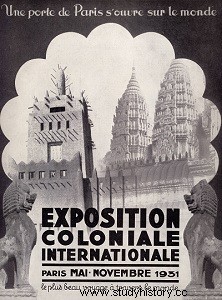
It is the pavilion of Syria, Lebanon, Palestine, it is the country of the Bible, the Koran and the Arabian Nights, designed by the architect Moussali. From the threshold of the pavilion, the magnificent Hittite lion of the Azem Palace in Damascus evokes one of the most distant cradles of our civilization. As also the sarcophagus of Ahiram, king of Byblos. Isn't Byblos the most important field of excavations in ancient Syria, with the enormous ruins of Palmyra and those of Baalbek, perhaps the most colossal that exist?
The painter Mourani , a Lebanese who became a Parisian, mentioned them in a room. A garden surrounds the pavilion with its greenery
and a kiosk shelters an architectural reconstruction, due to Jean Debs, of the temples of Baalbek.
Visitors to the exhibition were able to encounter here an authentic impression of that bliss that one tastes, at the foot of the mountain of Abraham, in the capital of the Umayyad caliphs, in the fairytale city bathed in a thousand streams, a hundred thousand murmuring basins and fountains of whitewater, among huge orchards and poplar woods.
The Missions pavilion is made up of two buildings. One is brought up by the Catholic Missions; the other by the Protestant Missions. The second is inspired in its exterior decoration by the shapes of bamboo. It is a vast, very simple room where one will follow the considerable effort of education, technical teaching and hygiene which, in 1931, relied on a staff of 257 European missionaries, men and women, 3,000 native collaborators, pastors, evangelists or teachers, and which requires a budget of approximately 4 million provided by voluntary donations.
The Catholic Missions pavilion has the appearance of a church where combined forms of architecture and decoration borrowed from the Far East and Africa. In the large nave, at the back, on a high platform, an altar is lit by a stained glass window. It represents Christ who advances, with open hands, to offer the world Charity and Peace.
Under the vaults, "as at the Invalides", are the standards of all peoples successively conquered to Christ. Another happy idea lies in having placed, near the entrance door, and sheltered by a dome, a world map 2.50 m in diameter on which each mission is indicated by a shiny sign. . The world map rotates on its axis and is illuminated, in the evening, by a projector which extends over it the sign of the Cross.
